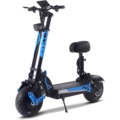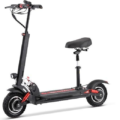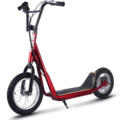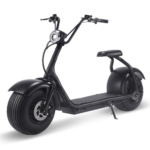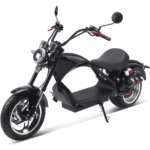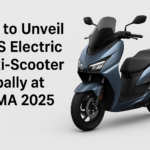- Home
- Scooters
- Electric Scooters
- MotoTec Mini Lowboy
MotoTec Mini Lowboy
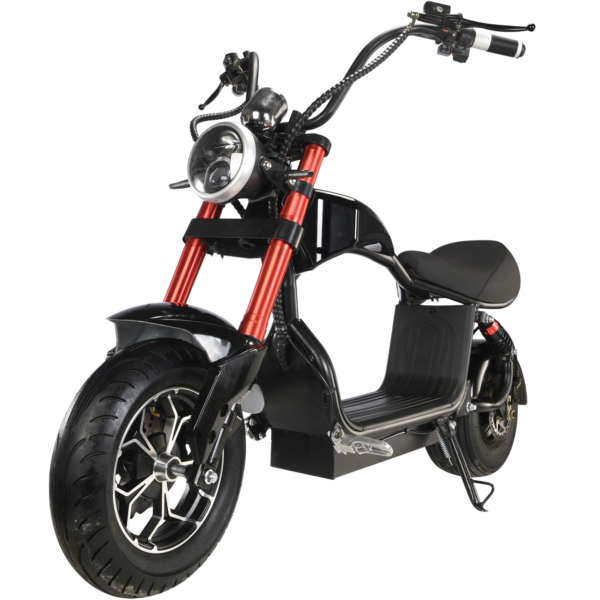


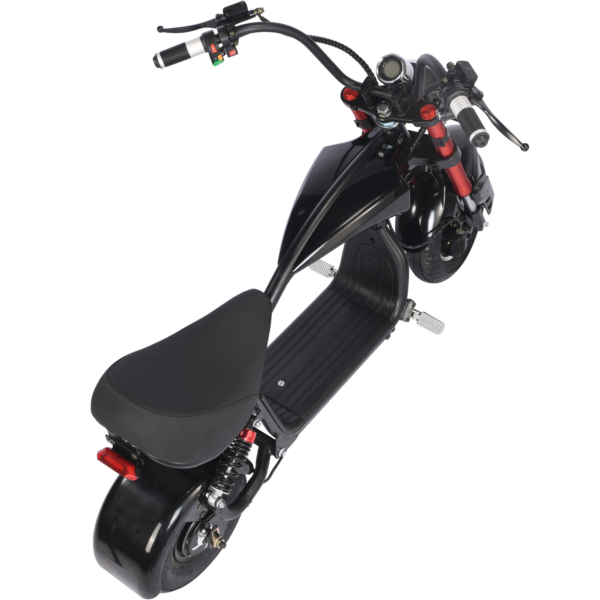
- Battery Range: 12–16 miles (19–26 km)
- Top Speed: 20 mph (32 km/h)
- Motor Power: 800 W (rear hub)
- Weight Capacity: 220 lb (100 kg)
- Charging Time: ~4–8 h
- Scooter Weight: Not specified
PROS
- 800W rear hub; selectable speed modes
- Hydraulic brakes front & rear
- LED lights plus blinkers & horn
- Compact mini-chopper geometry
- High-tensile steel frame
CONS
- Short 12–16 mi range
- Scooter weight not specified
- No IP rating listed
- No app connectivity
Key Takeaways
- The MotoTec Mini Lowboy is a compact seated electric scooter designed for comfort and stability.
- It features an 800-watt brushless hub motor, a 48-volt battery, and hydraulic disc brakes for smooth stops.
- Riders can expect a top speed of 20 mph (32 km/h) and a range of 12–16 miles (19–26 km) per charge.
- The scooter targets short urban commutes and offers easy handling for new riders, but isn’t ideal for long distances or rough trails.
- Regular maintenance includes checking tire pressure, cleaning brake rotors, and inspecting overall condition to ensure longevity.
Table of contents
- What Is the MotoTec Mini Lowboy?
- How the MotoTec Mini Lowboy Works
- Key Specifications
- Design & Build Quality
- Performance Fundamentals
- Battery, Range & Efficiency
- Ride Quality & Comfort
- Braking & Safety Features
- Portability & Daily Usability
- Maintenance & Care
- Weather & Seasonal Considerations
- MotoTec Mini Lowboy vs Alternatives
- Who the MotoTec Mini Lowboy Is (and Isn’t) For
- FAQs
- Glossary
The MotoTec Mini Lowboy is a low-slung, seated electric scooter with mini-chopper vibes. It pairs a relaxed riding position with wide street tires, hydraulic brakes, and a simple twist throttle. So it’s great for quick trips and easy cruising. And if you’re new to scooters, the clear controls make life simple.
What Is the MotoTec Mini Lowboy?
The MotoTec Mini Lowboy is a compact, seated scooter with a rear hub motor and a 48-volt lithium battery. It carries one rider and favors smooth, predictable power over top-speed bragging rights. You sit low and centered, so the scooter feels planted in turns. The wide tires add grip and calm the chatter from rough pavement. And the hydraulic brakes slow you down with a light pull.
You get a speedometer, a horn, LED lighting front and rear, and front turn signals. So you can see and be seen around town. The setup works best on clean pavement and gentle hills. And since the motor sits in the wheel, upkeep stays light.
How the MotoTec Mini Lowboy Works
Think simple e-bike basics, just with a laid-back stance. Each part does a clear job.
Motor. An 800-watt brushless hub hides in the rear wheel. It gives steady pull from a stop and keeps pushing up to the capped top speed. There’s no chain to oil and no gear whine, which is nice.
Controller. The controller manages power between the battery and motor. You twist the throttle, then the controller meters current so the scooter rolls out smoothly instead of jumping ahead.
Battery. A 48-volt, 12-amp-hour pack feeds the system. That’s about 576 watt-hours of energy. So you can think about range in simple budget terms: ride faster and you spend more, ride steadier and you save.
Throttle. A variable twist throttle sets speed. Small wrist moves equal small changes, which helps in tight spots. The spring is light, so longer cruises feel easy.
Brakes. Hydraulic discs front and rear do the stopping. You feel a firm bite about halfway through the lever pull, then power ramps up cleanly as you squeeze.
Key Specifications
Below is a clean view of the official specifications with both imperial and metric units. The Mini Lowboy does not fold, so folded dimensions don’t apply.
| Block | Details |
|---|---|
| General | Style: seated “mini chopper”; single rider. Recommended rider age: 13+ years. Max rider weight: 220 lb (100 kg). Handlebar: tilt adjustable. Non-folding frame (no folded dimensions). |
| Performance & Power | Motor: 800 W rear hub (brushless). Top speed: up to 20 mph (32 km/h). Speed modes: 2. Claimed max climbing angle: 15° (~27% grade). |
| Battery, Charging & Electrical | Battery: 48 V, 12 Ah lithium-ion (≈576 Wh). Typical charge time: 4–8 hours. Lighting: front and rear LEDs. Instruments & signals: speedometer, front blinkers, horn. |
| Build & Dimensions | Frame: high-tensile steel. Size (L×W×H): 65 × 14 × 43 in (165.1 × 35.6 × 109.2 cm). Seat height: 27.5 in (70 cm). Box size: 56 × 15 × 30 in (142.2 × 38.1 × 76.2 cm). Box weight: 103 lb (46.7 kg). Tires: 10 in front and rear. Suspension: front and rear shocks. |
| Safety & Control | Brakes: hydraulic disc front and rear. Horn and front turn signals. LED headlight and rear lighting. |
| Features & Extras | Variable twist throttle. Speedometer. Cruise Control: not provided. |
| Warranty & Compliance | Warranty: 30-day parts replacement. Compliance: not listed. Follow local riding rules. |
Design & Build Quality
This scooter puts stance first. The low seat and long wheelbase keep your weight low and centered, so straight-line tracking feels calm. The steel frame uses simple tubes and tidy welds, and you can feel that stiffness when you flick through quick lane checks.
The cockpit is clean. The speedometer is easy to read at a glance, and the switchgear sits where your thumbs expect it. The twist throttle has a short, light throw, so low-speed control comes naturally. The seat is broad and comfy for short daily rides. And with a tilt-adjust bar, most riders find a neutral reach without fuss.
Fit and finish are solid for the class. Plastics meet the metal parts without gaps, cables route cleanly, and the hydraulic lines use common fittings. So routine service stays simple. Keep the paint clean and it resists chips well.
Performance Fundamentals
Roll on the throttle and the scooter lifts off with a smooth push. It doesn’t lurch, which makes parking-lot moves feel safe. The pull stays steady to around 15 mph, then it eases into a cruise as you near the 20 mph cap. So range stays sensible and the chassis feels stable.
Stability is a strong point. The long wheelbase and wide tires fight wobbles, and the low seat helps you react to bumps without big body shifts. Quick inputs feel natural, then the scooter settles back into a straight line without drama.
On hills, grade matters. On a 7–10% climb, it will make steady progress if you carry a bit of momentum. Hill starts at 10% feel slower than on flat ground, so give yourself extra room. The 15° claim looks like a short-pitch limit, not an all-day target, and that’s fair for this motor size.
Battery, Range & Efficiency
The pack stores about 576 Wh, which is your energy budget for the ride. Cruise near top speed and you’ll spend that budget faster. Cruise at a steady pace and you’ll stretch it.
Plan for roughly 12–16 miles (19–26 km) per charge. Heavier riders, lots of stops, cold air, and headwinds will pull you toward the low end. Lighter riders on warm, smooth streets land near the high end. Tire pressure matters more than people think, so check it weekly and stay within the sidewall range. Charging from low takes about 4–8 hours, so plan your plug-in time around your schedule.
A few habits help the pack last:
- Don’t store it empty for weeks. Aim for roughly half to three-quarters if it will sit.
- Top up after long rides that drain most of the pack, then let it rest at room temp.
- Charge in a cool, dry place and unplug when the indicator shows full.
The powertrain stays quiet. You’ll hear a little motor whir on hard throttle, and that’s about it. So low-speed control in shared spaces feels calm.
Ride Quality & Comfort
The 10-inch street tires add grip and a bit of cushion. They take the sting out of cracks and seams, so the chassis stays composed on patchy pavement. The front and rear shocks help, too. They’re not long-travel, yet they shave the edges off pothole lips and expansion joints. Keep speeds modest on broken roads and the scooter stays settled.
The seat supports a neutral hip angle, and the low height lets most riders flat-foot at stops. That gives confidence in traffic. The tilt-adjust bar helps you dial reach, and the deck area leaves room for a relaxed stance. The frame feels stiff through S-turns and stem flex stays low. So the front end feels steady at city speeds.
Vibration stays in check. Your hands don’t buzz and the brakes don’t shudder under a firm pull. So longer neighborhood loops feel easy.
Braking & Safety Features
Hydraulic discs give strong, predictable stops. The first squeeze is light, then power builds in a clean arc as the pads bite. Practice a few hard stops in a safe lot, then you’ll know where the tire limits sit. On dry pavement, the front does most of the work. On wet roads, shift a bit more to the rear and leave extra room. And keep an eye out for paint lines and metal plates, since they get slick.
Lighting covers the basics. A front LED helps you see at low speeds and makes you visible to others. The rear lighting helps from behind, and the front blinkers add clarity at intersections. The horn grabs attention when you need it. So the full set makes dusk rides easier and safer.
Portability & Daily Usability
This scooter is built to be ridden, not carried. The box ships at about 103 lb (46.7 kg), and the complete frame is stout. So plan to roll it into parking rather than lump it up stairs. A small storage nook or garage bay works well. A simple U-lock through the frame and a fixed post adds peace of mind for quick errands. For a clear checklist on locks, alarms, trackers, and smart parking habits, read the Scooter Theft-Proofing Playbook.
The scooter does not fold. Measure storage with the full length in mind: about 65 in (165 cm). The side stand holds it upright on flat ground. On hot days, use a small puck on soft asphalt so the stand doesn’t sink. Leave some room near the rear wheel for charger access.
Build a quick routine and stick to it:
- Check tire pressure once a week and add air if needed.
- Squeeze both brake levers before you roll, and listen for pad rub.
- Glance at the battery gauge and plan your return charge window.
- Every few weeks, check bar-clamp bolts and caliper mounts. Then re-torque if they’ve moved.
Short hops are its sweet spot. Think errands, campus loops, and calm city commutes. The size and weight come from the tough frame and wide tires, so plan parking with that in mind.
Maintenance & Care
A small tool kit and a short checklist keep the Mini Lowboy happy.
Every ride. Thumb-check tire pressure if you don’t have a gauge. Make sure both levers feel firm. Scan the bar clamp, calipers, and rear axle for anything loose. Then look over the tires for cuts.
Weekly. Set pressure with a gauge. Wipe brake rotors with a clean, dry cloth. Check the tread for glass. Watch the brake lines and cable jackets for rub points. Confirm the kickstand snaps up and down cleanly.
Monthly. Inspect brake pad thickness. If lever travel grows, bleed the system or swap pads. Verify bar-clamp torque with a small torque wrench. Make sure the throttle snaps back to idle. Then check the rear axle hardware for any shift.
Battery habits. Avoid running the pack to zero on purpose. Plug in after long rides. If it will sit for more than a month, leave it near half. Then give it a brief top-up every few weeks. Keep the charger dry and the contacts clean.
Seasonal. Walk every fastener front to back. Replace worn tires as a set to keep handling balanced. Fresh pads each year make sense if you ride a lot. Touch up paint chips to keep rust from starting.
Weather & Seasonal Considerations
There’s no published IP rating, so treat heavy rain as a no-go. Light mist and the odd splash happen in real life, but water reduces grip and can reach electronics. So slow down when streets are wet and brake earlier than usual. Cross paint lines and metal covers upright.
Heat and cold change range. Warm days help the pack sag less, so range can tick up a bit at steady speeds. Cold days drop voltage and usable capacity, so expect fewer miles below 50°F (10°C). Start with a few gentle blocks to warm the tires in chilly weather. Then store and charge in a dry, room-temperature place.
If you ride through winter, rinse road salt off the wheels and frame, then dry the scooter to prevent corrosion. Lube the kickstand pivot now and then so it keeps moving freely. Small silicone sleeves on exposed connectors add a layer of protection.
MotoTec Mini Lowboy vs Alternatives
The Mini Lowboy shines when you want seated comfort and a calm, planted feel. Against small stand-up commuters, it brings more comfort and stability, plus stronger braking with hydraulics. Long rides feel easier on a seat.
Against bigger performance scooters, you trade away speed and range. In return, you get simpler upkeep, less to adjust, and a friendlier learning curve. You’re not managing dual motors or big clamps, and you still get a stable ride on city streets.
Against off-road builds, you give up knobby tires and ground clearance. What you get back is wide street rubber, a low seat, and smooth manners on pavement. If your route is mostly paved, that’s a win. If you see dirt and deep gravel often, a purpose-built off-road model will feel better. And if you want a different form factor from the same brand, the MotoTec Metro is a solid alternative with a simple, city-friendly setup.
Who the MotoTec Mini Lowboy Is (and Isn’t) For
Great for:
- Riders who want a seated, relaxed ride at city speeds
- Short commutes under 10 miles (16 km) round trip
- Campus loops, beach paths, and neighborhood errands
- New riders who value simple controls and strong brakes
Not ideal for:
- Long cross-town runs where high speed and big range matter
- Carrying up stairs or living in a walk-up
- Rough trails or deep gravel
So if you picture short, fun rides with a comfy seat and easy controls, this scooter fits well. And if your day needs long range or steep-hill punch, a larger battery and motor will serve you better.
FAQs
1) How fast does the Mini Lowboy go?
It tops out around 20 mph (32 km/h). You can pick from two speed modes if you want gentler starts.
2) What is the real-world range?
Plan for 12–16 miles (19–26 km) per charge. Rider weight, speed, stops, and weather all move that number.
3) Does it climb hills?
Yes, on moderate grades. On a 7–10% hill it climbs if you enter with some momentum. Starts on steep blocks feel slower, so give yourself space.
4) Is there Cruise Control?
No. You hold speed with the twist throttle.
5) What maintenance does it need?
Check tire pressure, watch pad wear, and keep bolts snug. Then top up the battery after longer rides.
6) Is the MotoTec Mini Lowboy overview good for new riders?
Yes. It focuses on the basics, ride feel, and simple care that help you get rolling fast.
7) Where can I find the full specifications?
See the table in this guide for the full specifications.
Glossary
Ah (amp-hours). Battery capacity. Multiply Ah by voltage to estimate watt-hours.
Wh (watt-hours). Total energy stored. More Wh often means more range.
Brushless hub motor. A motor built into the wheel. It runs quiet and needs little care.
Controller. The box that meters power from the battery to the motor.
Twist throttle. A handgrip you rotate to set speed.
Hydraulic disc brake. Fluid pushes pads onto a rotor for strong, smooth stops.
Regen. Regenerative braking that puts energy back in. Not listed on this model.
Stem flex. Bending you feel in the steering column. Less flex means a steadier feel.
IP rating. A water and dust code. None is published here.
Grade (%). Hill steepness. Ten percent means a 10 m rise over 100 m.
Watt (W). Power. More watts can mean quicker acceleration.
Wh/mi (watt-hours per mile). Energy use. Lower numbers mean better efficiency.
Bite point. The spot in the lever pull where pads engage firmly.
Wheelbase. Distance between wheel centers. Longer often feels more stable.
Specifications
General
| Model The Model specifies the exact version or name of the scooter. It helps identify its unique design, features, and specifications within the manufacturer’s product line. Knowing the model makes it easier to compare options, find compatible accessories, or look up support information. | Mini Lowboy |
| Brand The Brand identifies the manufacturer or company that designs and produces the scooter. A trusted brand is a sign of quality, reliability, and good customer support. Well-known brands often have higher standards for safety, performance, and after-sales service, giving you more confidence in your purchase. | MotoTec |
| Release Date The Release Date indicates when the scooter model was officially launched on the market. This helps you know how current the design, technology, and features are. A newer release date often means updated components, improved performance, and the latest safety or smart features. | 18 November 2025 |
| Recommended Age Recommended Age indicates the minimum age range that the scooter is designed for, based on safety, size, and ease of use. Following the recommended age helps ensure that riders can handle the scooter’s speed, weight, and controls comfortably and safely. Always check local laws and use protective gear, especially for younger riders. | 13+ |
Performance & Power
| Motor Power (Wattage) What it means: The motor power, measured in watts (W), shows how strong the scooter’s electric motor is. Why it matters: Higher wattage usually means better acceleration, more torque, and improved performance on hills or rough terrain. For example, a 250W motor is good for flat city roads and light riders, while a 500W or 1000W motor provides more power for faster speeds or climbing steep inclines. | 800 W rear hub motor |
| Top Speed The Top Speed indicates the maximum speed that the scooter can reach under optimal conditions. It’s usually measured on level ground with a fully charged battery and an average rider weight. A higher top speed allows you to travel longer distances faster, but always ensure you ride within legal speed limits and your personal comfort zone for safety. | 20 mph (32 km/h) |
| Battery Capacity Battery Capacity refers to the total amount of energy the scooter’s battery can store, usually measured in ampere-hours (Ah) or watt-hours (Wh). A higher battery capacity means you can ride longer distances on a single charge, reducing the need for frequent recharging. Keep in mind that actual range can vary depending on rider weight, terrain, speed, and weather conditions. | 48 V 12 Ah (≈576 Wh) |
| Estimated Range per Charge The Estimated Range per Charge indicates the average distance the scooter can travel on a single full battery charge. This range is calculated under optimal conditions, such as flat terrain, moderate speed, and average rider weight. Real-world range may vary depending on riding style, terrain, weather, and load. A longer range means fewer recharges and greater freedom for longer trips. | 12–16 miles (19–26 km) |
| Hill Climb Ability Hill Climb Ability describes the maximum incline or slope that the scooter can handle while maintaining stable performance. It’s typically expressed as a percentage or in degrees. A higher hill climb rating means the scooter can tackle steeper hills without losing too much speed or power. Actual climbing performance may vary based on rider weight, battery charge, and terrain conditions. | Up to 15° |
| Drive System The Drive System refers to how power from the motor is delivered to the wheels. Electric scooters typically use either a hub motor (directly integrated into the wheel) or a chain/belt drive system. A high-quality drive system ensures smooth acceleration, efficient power transfer, and low maintenance. The choice of drive system affects performance, noise level, and overall ride experience. | Rear hub (RWD) |
Charging & Electrical
| Charging Time Charging Time indicates how long it takes to fully recharge the scooter’s battery from empty to 100% using the standard charger provided. Faster charging means less downtime and more time on the road. Actual charging time may vary slightly depending on battery capacity, charger output, and environmental conditions. | Approx. 4–8 hours |
| Battery Type Battery Type refers to the specific technology used in the scooter’s battery, which affects performance, lifespan, weight, and charging time. Most modern electric scooters use high-quality lithium-ion (Li-ion) batteries because they offer a good balance of energy density, durability, and low maintenance. A reliable battery type ensures consistent power delivery and longer riding ranges. | Lithium-ion pack |
| Removable Battery A Removable Battery means the battery pack can be easily detached from the scooter for convenient charging and replacement. This feature allows you to charge the battery separately, swap it with a spare for extended range, or securely store it indoors in extreme weather. Removable batteries add flexibility and make it easier to keep your scooter powered up wherever you are. | Non-removable internal battery (fixed pack) |
| Regenerative Braking Regenerative Braking is an energy-saving feature that converts some of the energy normally lost during braking back into battery power. When you slow down or brake, the motor works in reverse to generate electricity, which helps extend the scooter’s range and improves overall efficiency. This system also reduces wear on traditional brake components, leading to lower maintenance over time. | Not specified |
| Lighting Lighting refers to the built-in front and rear lights that enhance visibility and safety when riding in low-light conditions or at night. Good lighting helps you see the road ahead and ensures that other road users can see you. Many scooters include LED headlights, taillights, and sometimes brake lights or side reflectors for added safety and compliance with local traffic regulations. | Front & rear LED lights; front blinkers; horn |
Build & Dimensions
| Scooter Weight Scooter Weight refers to the total weight of the scooter when fully assembled, including the battery. This affects how easy it is to carry, lift, and store the scooter when not in use. A lighter scooter is more portable and convenient for commuting, especially if you need to carry it upstairs or onto public transport. Keep in mind that a sturdy frame and quality components may add to the weight but also contribute to better durability and ride stability. | Not specified |
| Maximum Rider Weight Maximum Rider Weight indicates the highest rider weight that the scooter is designed to safely support while maintaining optimal performance and stability. Staying within this limit helps ensure reliable acceleration, braking, and climbing ability, and it protects the frame, suspension, and motor from excessive strain. Exceeding the recommended limit may reduce performance and increase wear on components. | 220 lb (100 kg) |
| Deck Size Deck Size refers to the dimensions of the scooter’s standing platform. A wider and longer deck provides more foot space, allowing you to stand comfortably and adjust your stance while riding. A well-sized deck improves balance and stability, especially on longer rides or at higher speeds. Compact decks, on the other hand, help keep the scooter lightweight and portable. | Mini chopper style; low seat |
| Handlebar Height Handlebar Height refers to the distance from the deck to the handlebars, which affects your riding posture and comfort. An appropriate handlebar height helps you maintain good balance, reduces strain on your back and arms, and makes steering more comfortable. Some scooters have adjustable handlebars to fit riders of different heights, while others have a fixed height for a streamlined design. | Adjustable (tilt only; range not specified) |
| Folding Mechanism The Folding Mechanism describes how easily and securely the scooter can be folded for carrying and storage. A well-designed folding system lets you quickly collapse the scooter into a compact size, making it convenient to transport on public transit, store under a desk, or fit into a car trunk. Look for sturdy latches and safety locks to ensure the scooter stays firmly in place when folded or unfolded. | Not foldable |
| Dimensions Folded Dimensions indicate the size of the scooter when it’s fully folded. This measurement shows how much space the scooter will take up when stored or carried, making it easier to check if it will fit in your car trunk, under a desk, or in a closet. Compact folded dimensions are ideal for commuters who need to bring their scooter on public transport or store it in tight spaces. | Unfolded: 65 × 14 × 43 in (165.1 × 35.6 × 109.2 cm); Folded: Not specified |
| Material Material refers to the primary construction materials used for the scooter’s frame and key components. High-quality materials like aircraft-grade aluminum, reinforced steel, or durable composites provide strength, stability, and a lighter overall weight. A sturdy material ensures the scooter can handle daily wear and tear while maintaining safety and performance. | High-tensile steel |
Safety & Control
| Brake Type(s) Brake Type(s) describe the braking systems the scooter uses to help you slow down or stop safely. Common brake types include mechanical brakes (like drum or disc brakes), electronic brakes, and foot brakes. Many scooters combine multiple braking systems for added safety and shorter stopping distances. The type and quality of brakes affect your control, especially when riding at higher speeds or on slopes. | Hydraulic brakes front & rear |
| Suspension Suspension refers to the system that absorbs shocks and vibrations while riding, providing a smoother and more comfortable ride over uneven or rough surfaces. Scooters may have front suspension, rear suspension, or dual suspension for better shock absorption and stability. Good suspension helps reduce rider fatigue and improves control, especially when riding on bumpy roads or off-road paths. | Front & rear suspension |
| Tire Type Tire Type refers to the kind of tires the scooter uses, which directly affects ride comfort, traction, and maintenance. Common types include solid (airless) tires, pneumatic (air-filled) tires, or hybrid options. Pneumatic tires offer better shock absorption and a smoother ride on rough surfaces, while solid tires are puncture-proof and require less upkeep. The right tire type helps ensure safe handling and a comfortable ride in different conditions. | 10″ tires (type not specified) |
| Tire Size Tire Size indicates the diameter and width of the scooter’s tires, which affect ride comfort, stability, and how well the scooter handles different terrains. Larger tires generally offer better shock absorption and a smoother ride over bumps and rough surfaces, while smaller tires keep the scooter lighter and more portable. Choosing the right tire size helps ensure a balance between agility and comfort. | 10-inch |
| Kickstand The Kickstand is a built-in stand that allows you to park your scooter upright when it’s not in use. A sturdy kickstand keeps the scooter stable and prevents it from tipping over, protecting it from scratches and damage. It also makes storing and accessing your scooter more convenient, whether you’re at home, work, or on the go. | Not specified |
| Water Resistance Rating Water Resistance Rating indicates how well the scooter is protected against water and moisture, usually shown as an IP (Ingress Protection) rating. This rating helps you understand whether the scooter can handle light rain, splashes, or wet roads without damage. While most scooters are not fully waterproof, a good water resistance rating adds peace of mind when riding in changing weather conditions. Always avoid deep puddles or submerging the scooter to protect its electrical components. | Not specified |
Features & Extras
| Display/Console The Display (or Console) shows important real-time information about your ride, helping you monitor your scooter’s status at a glance. Typical displays show speed, battery level, distance traveled, and riding mode. Some models also include additional features like Bluetooth connectivity, app integration, or backlighting for better visibility at night. A clear and easy-to-read display enhances safety and convenience on every trip. | Speedometer |
| Ride Modes Ride Modes refer to the different speed and power settings you can choose to match your riding style or road conditions. Common modes include eco for maximum range and energy efficiency, standard for everyday balance, and sport or turbo for higher speed and stronger acceleration. Switching between ride modes allows you to customize performance, conserve battery, and ride safely in various environments. | Selectable speed modes |
| Smart App Connectivity Smart App Connectivity lets you pair your scooter with a dedicated mobile app via Bluetooth. Using the app, you can monitor real-time ride stats like speed, battery level, and range, adjust settings such as ride modes or cruise control, lock the scooter for added security, and sometimes receive firmware updates. This feature adds convenience and allows you to personalize your riding experience right from your smartphone. | No app |
| Anti-Theft System The Anti-Theft System helps protect your scooter from unauthorized use or theft. This feature can include built-in alarms, electronic motor locks, GPS tracking, or remote locking through a mobile app. A good anti-theft system provides peace of mind when parking your scooter in public spaces, adding an extra layer of security to safeguard your investment. | Not specified |
| Cruise Control Cruise Control allows you to maintain a steady speed without continuously holding the throttle. This feature makes longer rides more comfortable by reducing hand fatigue and providing a smoother, more relaxed riding experience — especially on flat, open roads or bike lanes. For safety, cruise control can usually be easily activated or deactivated while riding. | Not specified |
| Accessories Included Accessories Included lists the additional items that come with the scooter to enhance your riding experience and convenience. Common accessories may include a charger, kickstand, bell, lights, phone holder, or carrying strap. These extras add value by making your scooter safer, easier to use, and ready to ride straight out of the box. | Not specified |
Warranty & Compliance
| Warranty Period The Warranty Period indicates how long the manufacturer guarantees the scooter against defects in materials and workmanship under normal use. A good warranty provides peace of mind, showing the brand’s confidence in its product quality. Always check what parts are covered, such as the frame, battery, and motor, and follow the maintenance guidelines to keep your warranty valid. | 30 days parts replacement |
| Certifications Certifications confirm that the scooter meets specific safety, quality, and environmental standards set by recognized organizations or regulatory bodies. Common certifications may include CE, RoHS, UL, or other local compliance marks, depending on your region. These certifications ensure that the scooter is manufactured to high standards and is safe and legal to use in your country. | UL 2272 (brand statement); region-dependent |


